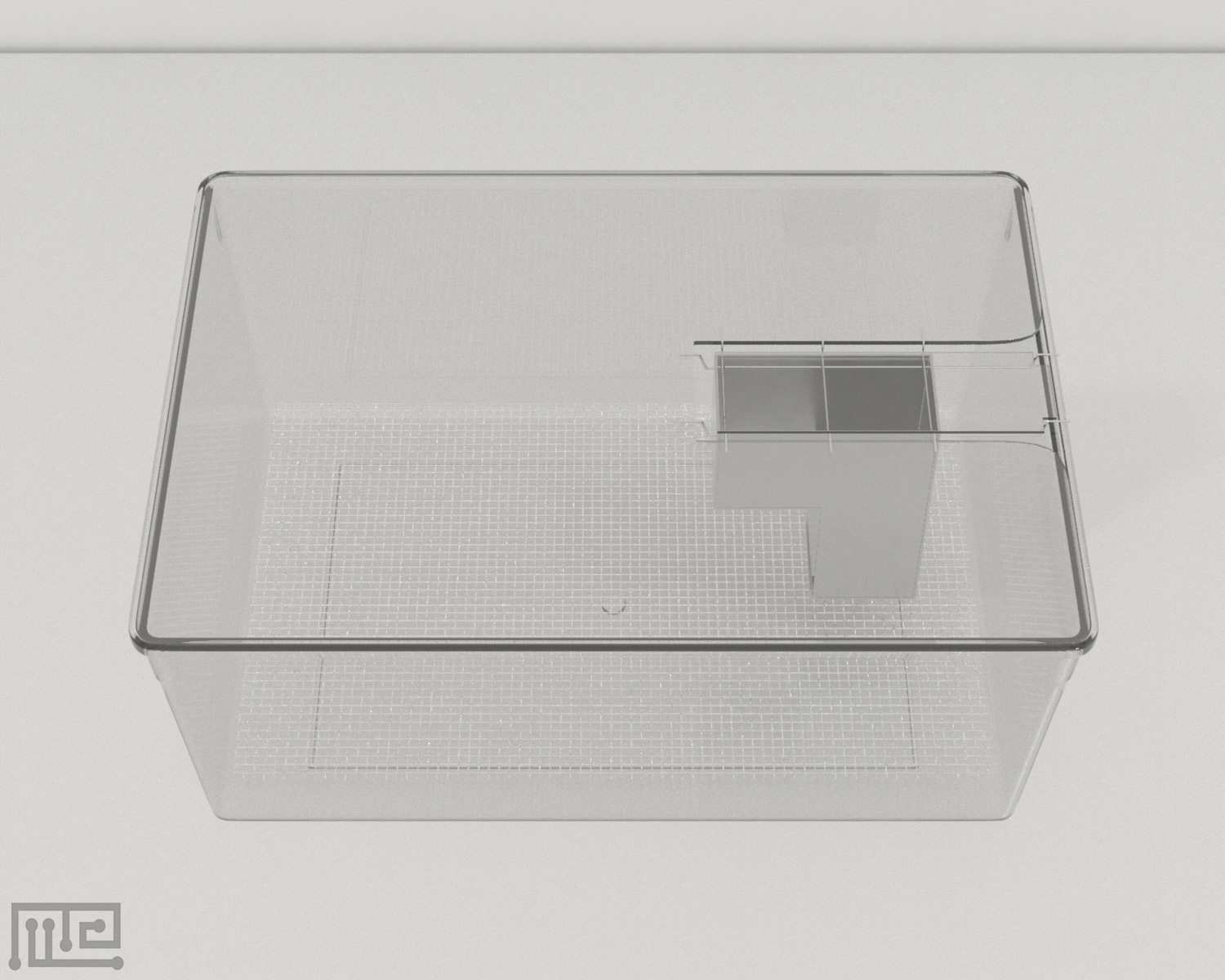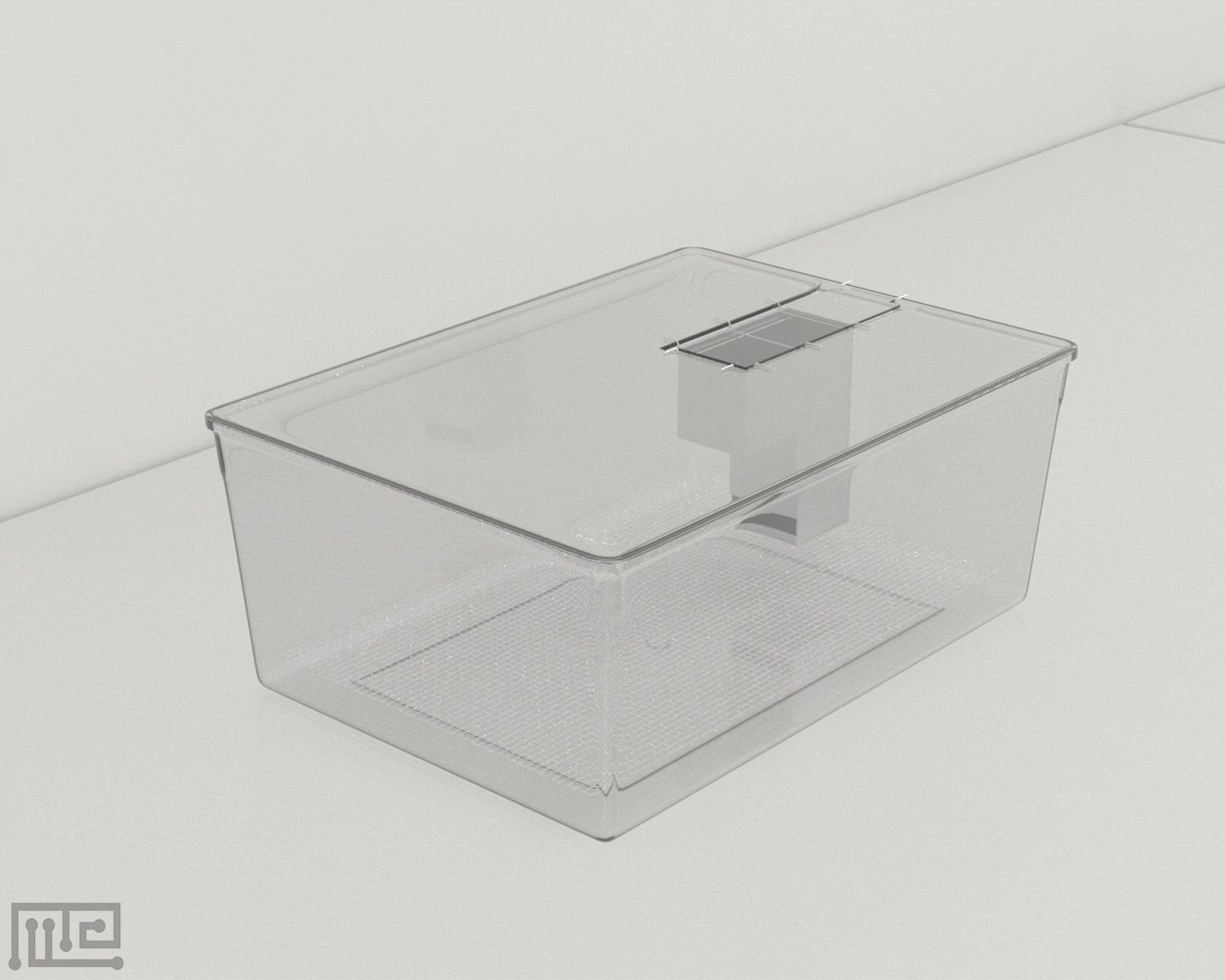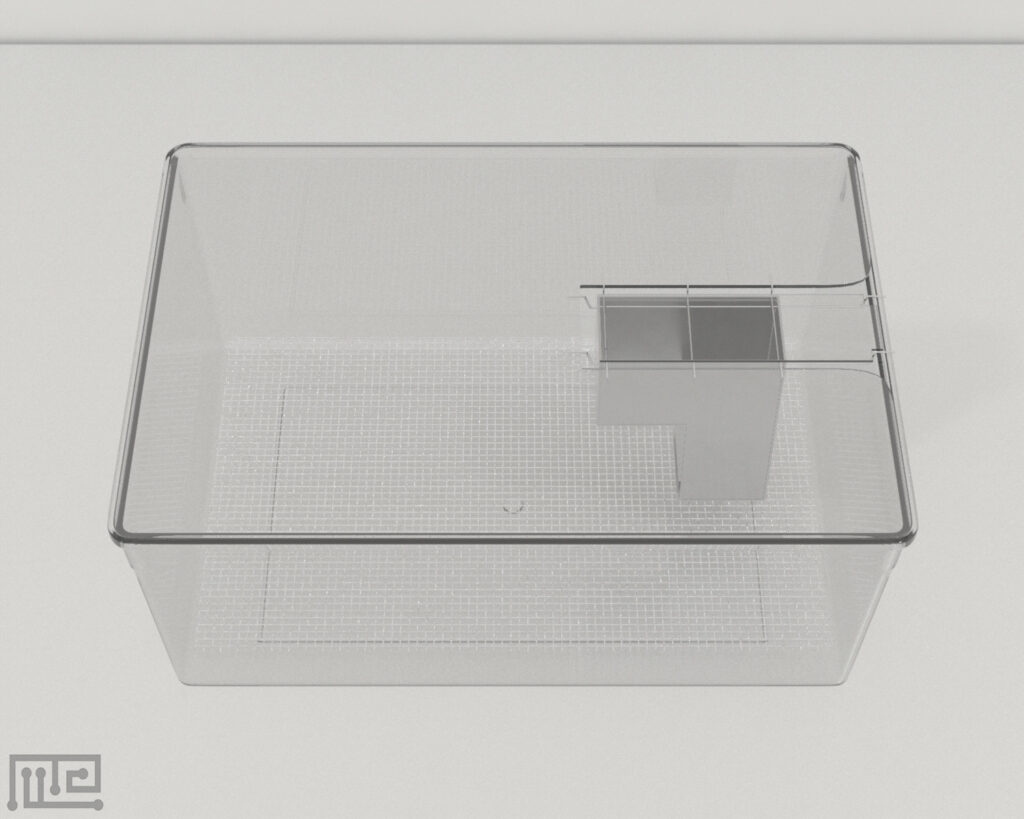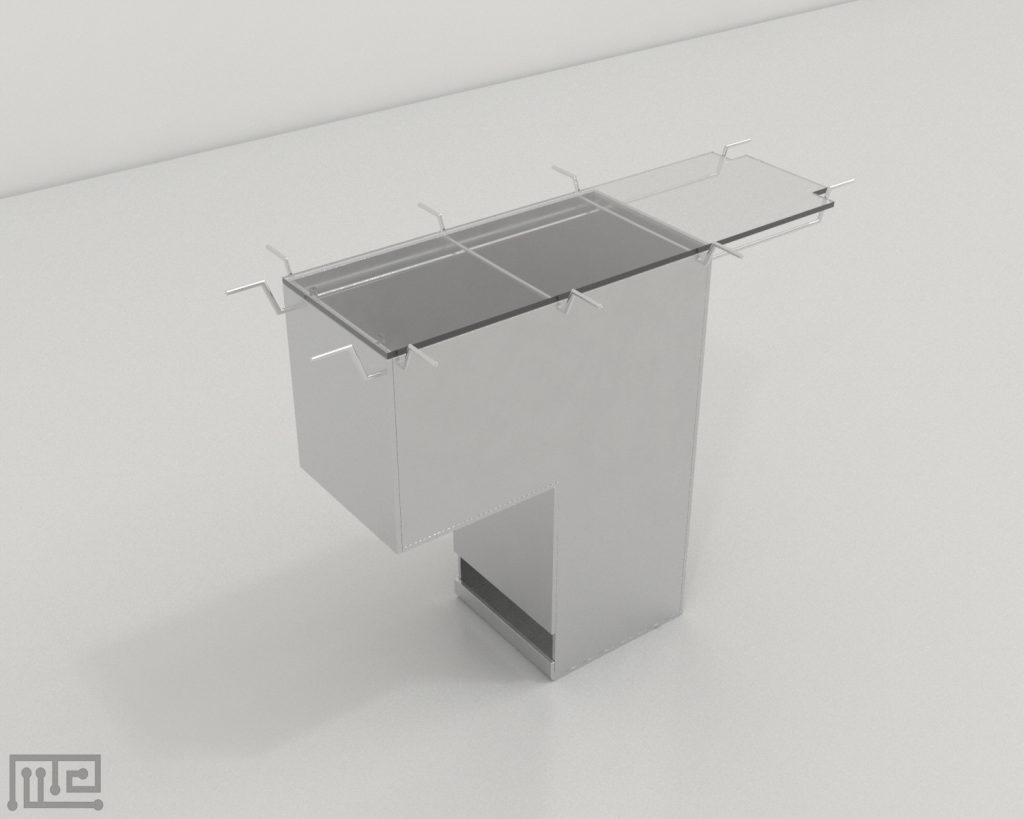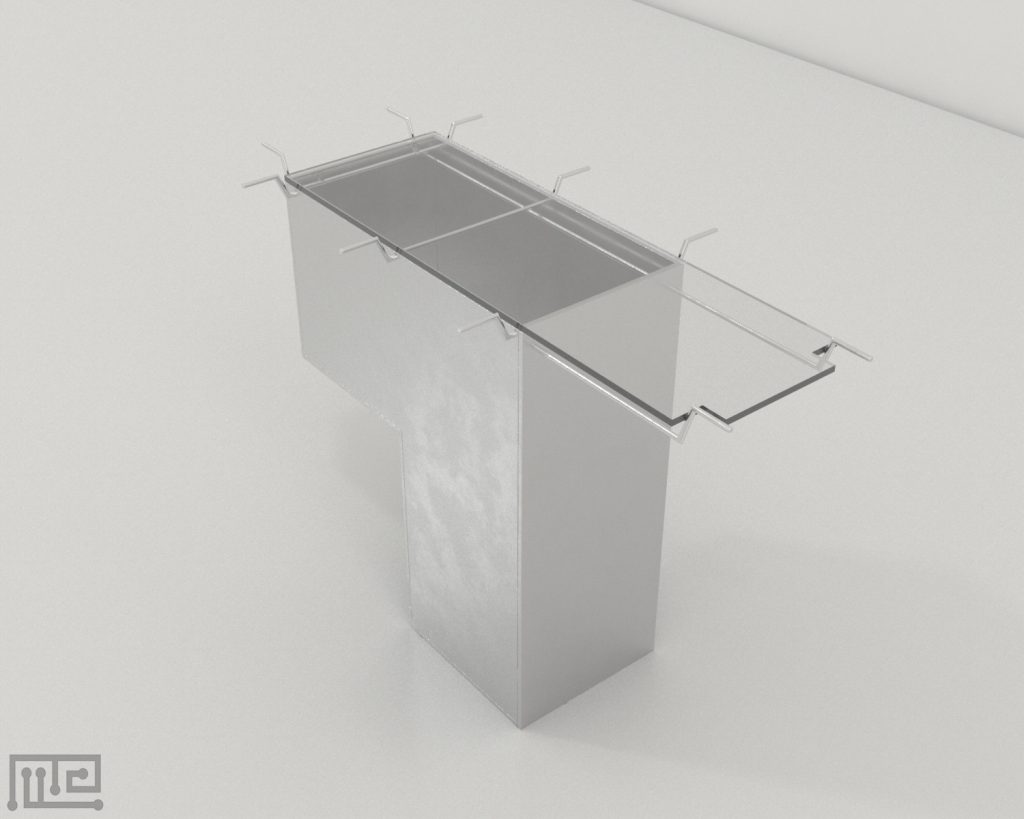The Food Hopper was used by Spiteri, Nello J. (1979) to behavioural effects of oestradiol in the female rat.
Rats were housed individually in plastic cages. Coprophagia was prevented by a removable galvanised wire grid above the bottom of the cage.
Dry, powdered food (Rat and mouse maintenance diet No. 1, BP Nutrition , Witham) was available in a metal food hopper, which was attached to the top of the cage, but easily removable. The bottom of the hopper was above the metal grid .
Mazeengineers offer the Food Hopper.
Price & Dimensions
Mouse
$ 1890
+S&H- Length of plastic cages: 28cm
- Width of plastic cages: 20cm
- Height of plastic cages: 11.3cm
- Position of galvanised wire grid: 2cm above the bottom of the cage
- Position of bottom of hopper: 1cm above the metal grid
Rat
$ 1990
+S&H- Length of plastic cages: 42cm
- Width of plastic cages: 30cm
- Height of plastic cages: 17 cm
- Position of galvanised wire grid: 2cm above the bottom of the cage
- Position of bottom of hopper: 1cm above the metal grid
Documentation
Introduction
The Food Hopper is used to measure food intake and monitor the feeding patterns of rodents. The rodents differ in their feeding patterns, and their food consumption can be affected by the administration of several food inhibitors and food stimulators such as appetitive suppressants and peptide hormones (Naef & Woodside, 2007; Wellman, 2008). The Food Hopper can effectively and easily be used to measure food intake in rodents by weighing it before and after food ingestion trials. It is made of metal and shaped like an upside-down “L.” Since spillage also contributes to the weight of the food, the particular L-shaped design helps keep spillage down to a minimum. Furthermore, the Food Hopper also comes with a plastic cage that is designed to help collect spillage. A galvanized wire grid is placed 2 cm above the bottom of the cage, and the Food Hopper is placed 1 cm above the wire grid. Any spillage falls beneath the wire grid and can easily be collected and weighed. Even though the Food Hopper comes with a cage, it can easily be removed to deprive subjects of food according to experimental needs or be attached to any other cage.
Apart from measuring the effects of different substances on food intake, the Food Hopper can also be used to measure food preferences in subjects, which is an important factor that can affect many experiments (Vento, Swartz, Martin, & Daniels, 2008). Different types of food can be placed in the Food Hopper to observe differences in food consumption and feeding pattern behaviors in the subjects. Moreover, the Food Hopper can also be used to observe the effect of brain lesions, pharmacological manipulations, and diseases and disorders on feeding behaviors.
Other apparatuses used to study rodent behavior include the Linear Maze, the Dig Task, and the Puzzle Box.
Apparatus and Equipment
The Food Hopper is made of metal and is shaped like an upside-down “L.” The longitudinal arm is used to store food and measures 5 cm x 5 cm x 7 cm. The longitudinal arm also contains an opening for the subjects to access the food. The horizontal arm measures 10 cm x 5 cm x 5 cm. The Food Hopper comes attached to a plastic cage that measures 42 x 30 x 17 cm and is easily removable. A galvanized wire grid is placed 2 cm above the bottom of the cage, and the Food Hopper is placed 1 cm above the wire grid.
Training Protocol
Routinely fill the Food Hopper halfway. Appropriately light the cage. A tracking and recording system such as the Noldus Ethovision XT can be used to assist with observations.
The following is a sample protocol used to measure the amount of food consumed after a period of food deprivation in rats.
Food intake task
Place a subject in the cage with the Food Hopper attached. Allow the subject to remain in the cage and measure the subject’s food intake over the next 24 hours. Remove the Food Hopper from the cage and deprive the subject of food. After 24 hours, place the Food Hopper back into the cage. Measure the subject’s food intake over the next 24 hours.
Literature Review
Investigation of the effect of mazindol on food intake in rats
Wellman (2008) investigated the suppressive effect of mazindol on food intake in rats. Ten male Sprague-Dawley rats were used in the experiment and housed in individual cages that contained a Food Hopper. The Food Hopper contained 110 grams of soft pellet diet and was weighed at the start and end of a 3-hour food intake period. The food intake of the subject was monitored using 12 feeding modules that consisted of a Food Hopper, a load cell, and hardware/software. As the subjects consumed food, movements of the Food Hopper was detected on the load cell. A software program then analyzed the subjects’ meal pattern data. The subjects were acclimated to the colony room seven days before testing. On days 5-7, the subjects received daily sham injections (IP) of 0.9% saline (1 mL/kg), 10 minutes before food ingestion. The experiment was performed over six days in which the subjects received a different dose of mazindol (0, 0.25, 1.25, or 2.5 mg/kg) on the four drug test days. The subjects received continuous access to food and water for 21 hours after testing, which served as the two inter-trial test days where eating and drinking were recorded without drug administration. During drug test days, injections were administered 10 minutes before food ingestion trials, and testing was performed for 3 hours. The results of food intake and water intake by the subjects indicated that mazindol produced a dosed –dependent suppression over the 3-hour food intake period. The food intake at each of the mazindol doses was significantly different from the 0 mg/kg mazindol dose. The water intake at each of the mazindol doses also significantly decreased relative to that of the 0 mg/kg mazindol dose. Furthermore, mazindol administration also produced a dose-dependent suppression in average meal size.
Investigation of the effect of oestradiol benzoate on food intake in food-deprived female rats
Spiterri (1979) investigated the anorexic effect of oestradiol benzoate on food intake in ovariectomized female rats that had been food-deprived. Sixteen female hooded rats that were 120 days old were ovariectomized a month before starting the experiment. The rats were equally divided into two group cages and were transferred to individual plastic cages two weeks after ovariectomy. The rats were housed in reverse lightroom that has a 12 hour light and 12-hour dark cycle. The experiment was then performed over two weeks, in which the subjects were divided into control and experimental groups. The experimental group was treated with oestradiol benzoate using Arachis oil as the vehicle for injection, while the control group was only treated with Arachis oil. The subjects’ food intake was measured a day before food deprivation. On the food deprivation day, the Food Hopper was removed from their cages at 14.00 hours. The subjects were then injected with either 0.5 µg oestradiol benzoate in 0.1 ml Arachis oil or 0.1 ml Arachis oil. On the next day, the subjects were reinjected with the same substances at 9.00 hours. The Food Hopper was placed back into the cage at 14.00 hours, and the subjects’ food intake was measured over 24 hours. The subjects’ received no treatment over the next seven days for the hormones to eliminate from their bodies. After the seven days, the experiment was repeated; however, the treatment was reversed between the two groups such that the experimental subjects were now the control, and vice-versa. The results indicated that the control group consumed more food than the experimental group. The suppressive effects of estradiol benzoate on food intake were even seen after 24 hours of food deprivation.
Data Analysis
The following can be observed using the Food Hopper:
- The amount of food consumed by the subjects.
Strengths and Limitations
Strengths
The Food Hopper can easily be used to measure food intake and monitor feeding patterns of rodents. The upside-down “L” shaped design and the small opening used to access food from the Food Hopper helps reduce spillage to a minimum. The Food Hopper comes with a plastic cage that has a wire grid placed 2 cm from the bottom of the cage, therefore, if any spillage occurs, it falls beneath the wire grid and can easily be collected. The Food Hopper can easily be removed from the cage and also be used with other types of cages. Apart from measuring food intake, the Food Hopper can also be used to observe food preferences in rodents.
Limitations
Factors such as age, gender, and strain of the subject may affect task performance. Food preferences and food quality may affect food intake by the subjects.
Summary
- The Food Hopper is used to measure food intake and monitor the feeding patterns of rodents.
- It is made of metal and has an upside-down L-shaped design and contains a small opening to access food. The design of the Food Hopper helps reduce spillage to a minimum.
- The Food Hopper comes attached to a plastic cage but can easily be removed. The plastic cage has a wire grid placed 2 cm above the bottom of the cage, and the Food Hopper is placed 1 cm above the wire grid.
- The Food Hopper can be used to investigate the effects of appetite suppressants or stimulants on food intake. It can also be used to observe food preference behaviors.
References
- Naef, L., & Woodside, B. (2007). Prolactin/Leptin interactions in the control of food intake in rats. Endocrinology, 148(12), 5977–5983. https://doi.org/10.1210/en.2007-0442
- Spiteri, Nello J. (1979) Behavioural effects of oestradiol in the female rat. Durham theses, Durham University. Available at Durham E-Theses Online: http://etheses.dur.ac.uk/8301/
- Vento, P. J., Swartz, M. E., Martin, L. B., & Daniels, D. (2008). Food intake in laboratory rats provided standard and fenbendazole-supplemented diets. Journal of the American Association for Laboratory Animal Science: JAALAS, 47(6), 46–50.
- Wellman, P. J. (2008). Systemic mazindol reduces food intake in rats via suppression of meal size and meal number. Journal of psychopharmacology (Oxford, England), 22(5), 532–535. https://doi.org/10.1177/0269881107083837
Request a quote
"*" indicates required fields

